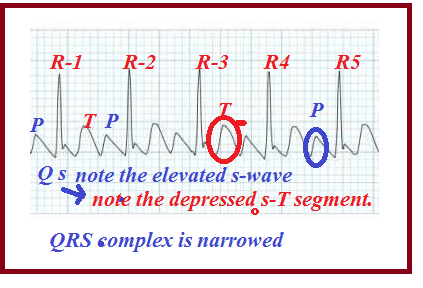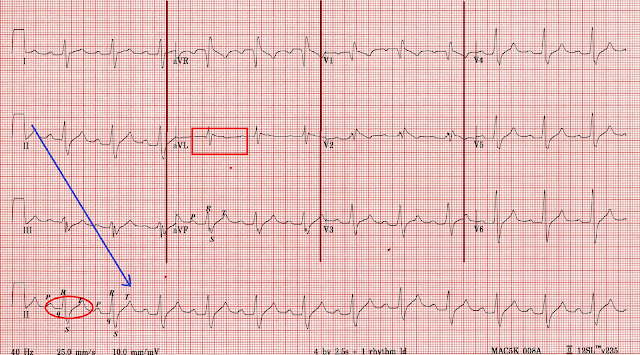ECG CHANGES DURING HYPERTHYROIDISM
 |
| Fig-1 |
Hyperthyroidism is a serious condition in which the thyroid gland becomes overactive and produces many complications.
The thyroid is a tiny butterfly-shaped gland that is located in front of the neck just below Adam's apple.
It is producing the hormone thyroxine (T4) and triiodothyronine T3 releasing them in circulation.T3 (Triiodothyronine) which is more active than T4 (tetraiodothyronine) is highly unstable and is soon converted into T4. For details click here.
Due to the following causes hyperthyroidism may occur.
1.Excessive intake of thyroid tablets
2.Excessive secretion of TSH (Thyroid Stimulating Hormone)
3.Grave's Disease.An autoimmune disease in which the thyroid gland produces more hormone.
4.Inflammations of the thyroid gland (Thyroiditis)
5.High iodine intake
6.Functioning adenoma
7.Severe Multinodular Goiter(SMNG)
Normally the body uses thyroid hormone to speed up metabolism, which raises and maintains the body temperature within limits.
But if the thyroid secretes high levels of the hormone then the temperature raises more rapidly with dangerous levels of anabolism and catabolism which raises energy level beyond the control. Blood pressure raises, with increased heart rate and many more complications.
Symptoms:-
1.Tremor, exciting, nervousness.
2.Anxiety
3.Tiredness, and weakness
4.Mood swings
5.High temperatures(Hyperthermia)
6.Sudden unexpected weight loss
7.Goiter(Swollen neck)
6.Increased heartbeats (Tachyarrhythmia), palpitations.
7.Rapid bowel movements
8.Sleeplessness
9.Thinning and brittle skin and hair.
10.Disturbed menstrual cycles.
Thyroid Storm:-
If hyperthyroidism is not properly cared for and treated in time it will lead to this acute condition in which all symptoms mentioned above will rise to a life-threatening dangerous level with fatal results.
ECG EFFECTS;-
In the above Fig-2A and Fig 2B note the records by Leads-II, III, I aVL, and aVF which give the picture of rapid heartbeats(tachyarrhythmias) by the narrowed QRS complex and the shortened R-R intervals.
Short P-R intervals indicate the rapid contractions of the atria followed by the immediate ventricular responses.
The depression of S-wave followed by elevation of the ST segment indicates the strain on the ventricles. These changes are predicting a heart attack to follow ventricular fibrillation.
Conclusively thyroid overactivity and thyroid storm should be treated in time to avoid fatal consequences.
(Next: Thyroid Under Activity)
2.Excessive secretion of TSH (Thyroid Stimulating Hormone)
3.Grave's Disease.An autoimmune disease in which the thyroid gland produces more hormone.
4.Inflammations of the thyroid gland (Thyroiditis)
5.High iodine intake
6.Functioning adenoma
7.Severe Multinodular Goiter(SMNG)
Normally the body uses thyroid hormone to speed up metabolism, which raises and maintains the body temperature within limits.
But if the thyroid secretes high levels of the hormone then the temperature raises more rapidly with dangerous levels of anabolism and catabolism which raises energy level beyond the control. Blood pressure raises, with increased heart rate and many more complications.
Symptoms:-
1.Tremor, exciting, nervousness.
2.Anxiety
3.Tiredness, and weakness
4.Mood swings
5.High temperatures(Hyperthermia)
6.Sudden unexpected weight loss
7.Goiter(Swollen neck)
6.Increased heartbeats (Tachyarrhythmia), palpitations.
7.Rapid bowel movements
8.Sleeplessness
9.Thinning and brittle skin and hair.
10.Disturbed menstrual cycles.
Thyroid Storm:-
If hyperthyroidism is not properly cared for and treated in time it will lead to this acute condition in which all symptoms mentioned above will rise to a life-threatening dangerous level with fatal results.
ECG EFFECTS;-
 |
| Fig-2A |
In the above Fig-2A a model ECG taken during Hyperthyroidism has been present for reference.
Observe the waves P, Q, R, S, and T.The normal rhythm is highly disturbed as we have seen in past articles. To get a detailed description of a normal sinus rhythm please click here.
 |
| Fig-2B |
Short P-R intervals indicate the rapid contractions of the atria followed by the immediate ventricular responses.
The depression of S-wave followed by elevation of the ST segment indicates the strain on the ventricles. These changes are predicting a heart attack to follow ventricular fibrillation.
Conclusively thyroid overactivity and thyroid storm should be treated in time to avoid fatal consequences.
(Next: Thyroid Under Activity)




















